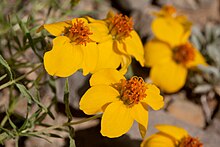| Zinnia grandiflora | |
|---|---|

| |
| Conservation status | |
 Apparently Secure (NatureServe) | |
| Scientific classification | |
| Kingdom: | Plantae |
| Clade: | Tracheophytes |
| Clade: | Angiosperms |
| Clade: | Eudicots |
| Clade: | Asterids |
| Order: | Asterales |
| Family: | Asteraceae |
| Genus: | Zinnia |
| Species: | Z. grandiflora |
| Binomial name | |
| Zinnia grandiflora Nutt. 1840 | |
| Synonyms | |
| |
Zinnia grandiflora is a species of flowering plant in the family Asteraceae known by the common names Rocky Mountain zinnia and plains zinnia. It is native to the southwestern and south-central United States (Kansas, Oklahoma, Texas, Colorado, New Mexico, Arizona) and northern Mexico (Chihuahua, Coahuila, Sonora, Tamaulipas, Nuevo León, Zacatecas). Zinnia grandiflora is used by many Native American tribes for its medicinal properties as well as for its vibrant yellow color for paint and dyes. There have also been experiments done using Zinnia grandiflora to understand the extent of its healing abilities.
Uses
Zinnia grandiflora is used for many things from medicinal purposes to dyes and paint. They are also non-toxic to pets.
This plant is used by several Native American groups, including the Zuni and Navajo, for medicinal and ceremonial purposes.
Among the Zuni people, this plant is applied in a poultice to bruises, cold infusion of blossoms used as an eyewash, and smoke from powdered plant inhaled in sweatbath for fever.
The Acoma and Laguna Indians used Zinnia grandiflora to heal kidney illnesses by drinking an infusion of it. It was also used on buckskins to dye them yellow. By adding the flower to water or white clay it can also be used to color wool. Scientists are also looking into other uses of Zinnia grandiflora as well.
Experiments
Zinnia grandiflora has also been used in a few experiments regarding irrigation and affects on mice. in one of those experiments, Texas AgriLife Research Center at El Paso, Texas A&M University System used six species of wildflowers native to North America were used to test their tolerance to salt in their irrigation. The wildflowers were Salvia farinacea (mealy cup sage), Berlandiera lyrata (chocolate daisy), Ratibida columnaris (Mexican hat), Oenothera elata (Hooker’s evening primrose), Zinnia grandiflora (plains zinnia), and Monarda citriodora (lemon horsemint). They discovered that Zinnia grandiflora had a very slow rate of growth and were all dead by the end of the experiment.
Another experiment done was an experiment on the effects of Zinnia grandiflora in mice, specifically using it as an anti-inflammatory and antiallodynic. Zinagrandinolide E was taken from Zinnia grandiflora plants and given to mice with either carrageenan-induced inflammation and tactile allodynia hyperglycemia. They found that ZGE was effective for treating the mice's inflammation pain.
Description and habitat

Zinnia grandiflora is a small flat-topped or rounded subshrub growing up to 22 cm (8+1⁄2 in) tall with many slender, branching stems. The oppositely arranged leaves are linear and 1–3 cm (1⁄2–1+1⁄4 in) long. The herbage is covered in short, rough hairs. The flower head has 3 to 6 bright yellow ray florets each between 1–2 cm (1⁄2–3⁄4 in) in length. At the center is a cluster of several tubular disc florets. It grows on plains and foothills and other dry habitats in the southwestern and south central states of the United States. It blooms from around April through November. Zinnia grandiflora grows best in the sun and with more dry soil. This flower is good for drier landscapes because they are "drought-tolerant" meaning they do not need lots of water to grow. Zinnia grandiflora can't live in wet conditions. this plant works very well to help fight erosion due to its rhizomes. Rhizomes are stems that grow horizontally to the ground making them very sturdy which helps stop erosion. They are also good for pollinators because they do not have any insect issues and will attract insects good for a garden such as butterflies.
References
- The Plant List, Zinnia grandiflora Nutt.
- ^ Flora of North America, Zinnia grandiflora Nuttall, 1840. Plains or Rocky Mountain zinnia
- Biota of North America Program 2014 county distribution map
- photo of herbarium specimen collected in Nuevo León in 1997
- Ethnobotany
- Stevenson, Matilda Coxe 1915 Ethnobotany of the Zuni Indians. SI-BAE Annual Report #30 (p. 45)
- Swank, G. R. (1932, January 1). The ethnobotany of the Acoma and Laguna Indians. UNM Digital Repository. https://digitalrepository.unm.edu/biol_etds/212/
- ^ Niu, G., Rodriguez, D. S., & McKenney, C. (2012). Response of selected wildflower species to saline water irrigation. HortScience, 47(9), 1351–1355. doi:10.21273/hortsci.47.9.1351
- Valeria Itzel Reyes-Pérez, Vinicio Granados-Soto, Manuel Rangel-Grimaldo, Myrna Déciga-Campos, and Rachel Mata 2021. Pharmacological Analysis of the Anti-inflammatory and Antiallodynic Effects of Zinagrandinolide E from Zinnia grandiflora in Mice 84 (3), 713-723 doi:10.1021/acs.jnatprod.0c00793
- ^ Zinnia grandiflora. Zinnia grandiflora (Golden Eye, Little Golden Zinnia, Plains Zinnia, Prairie Zinnia, Rocky Mountain Zinnia, Wild Zinnia, Yellow Zinnia) | North Carolina Extension Gardener Plant Toolbox. (n.d.). https://plants.ces.ncsu.edu/plants/zinnia-grandiflora/
- Plant of the week. Rhizomes. (n.d.). https://www.uaex.uada.edu/yard-garden/resource-library/plant-week/Rhizomes-12-06-2019-Ark.aspx
External links
![]() Media related to Zinnia grandiflora at Wikimedia Commons
Media related to Zinnia grandiflora at Wikimedia Commons
This Heliantheae article is a stub. You can help Misplaced Pages by expanding it. |
This Medicinal plants-related article is a stub. You can help Misplaced Pages by expanding it. |